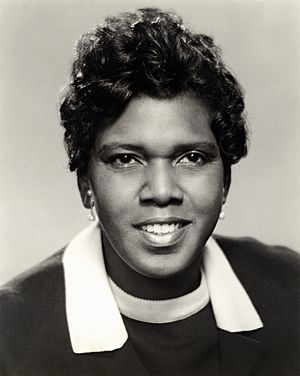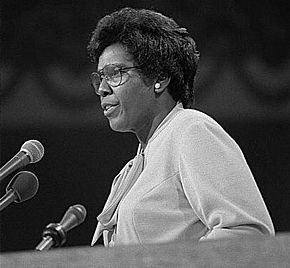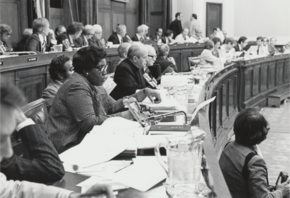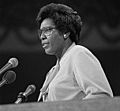Barbara Jordan facts for kids
Quick facts for kids
Barbara Jordan
|
|
|---|---|
 |
|
| Member of the U.S. House of Representatives from Texas's 18th district |
|
| In office January 3, 1973 – January 3, 1979 |
|
| Preceded by | Bob Price |
| Succeeded by | Mickey Leland |
| Member of the Texas Senate from the 11th district |
|
| In office January 10, 1967 – January 3, 1973 |
|
| Preceded by | Bill Moore |
| Succeeded by | Chet Brooks |
| Personal details | |
| Born |
Barbara Charline Jordan
February 21, 1936 Houston, Texas, U.S. |
| Died | January 17, 1996 (aged 59) Austin, Texas, U.S. |
| Political party | Democratic |
| Domestic partner | Nancy Earl (late 1960s–1996) |
| Education | Texas Southern University (BA) Boston University (LLB) |
Barbara Charline Jordan (February 21, 1936 – January 17, 1996) was an important American lawyer, teacher, and politician. She was a member of the Democratic Party. Jordan was the first African American woman elected to the Texas Senate after the Reconstruction era. She was also the first African American woman from the Southern United States elected to the United States House of Representatives.
Jordan is famous for her powerful speech during the House Judiciary Committee hearings. These hearings were about whether to remove President Richard Nixon from office. In 1976, she made history again. She became the first African American and the first woman to give a main speech at a Democratic National Convention. She received many awards, including the Presidential Medal of Freedom. She was also the first African American woman to be buried in the Texas State Cemetery. Jordan was also known for leading the U.S. Commission on Immigration Reform.
Contents
Early Life and Education
Barbara Charline Jordan was born in Houston, Texas, in an area called the Fifth Ward. Her childhood was very focused on church activities. Her mother, Arlyne Patten Jordan, was a church teacher. Her father, Benjamin Jordan, was a Baptist preacher. Barbara was the youngest of three children.
Jordan went to Roberson Elementary School. She graduated with honors from Phillis Wheatley High School in 1952. She said that a speech she heard in high school by Edith S. Sampson inspired her to become a lawyer.
Because of segregation (when Black and white people were kept separate by law), she could not attend the University of Texas at Austin. Instead, she chose Texas Southern University. This was a historically Black college. She studied political science and history there. At Texas Southern University, Jordan was a national champion debater. She beat teams from famous universities like Yale and Brown. She graduated with high honors in 1956. After college, she went to Boston University School of Law and graduated in 1959.
Jordan taught political science for a year at Tuskegee Institute in Alabama. In 1960, she moved back to Houston and started her own law practice.
Political Career
Jordan ran for the Texas House of Representatives in 1962 and 1964 but did not win. In 1966, she won a seat in the Texas Senate. This made her the first African American state senator in Texas since 1883. She was also the first Black woman to serve in that group. She was re-elected in 1968 and served until 1972. On June 10, 1972, she served for one day as acting governor of Texas. This made her the first African American woman to serve as governor of a state. During her time in the Texas Legislature, Jordan helped create or support about 70 new laws.
In 1972, Jordan was elected to the U.S. House of Representatives. She was the first woman from Texas elected to the House on her own. Former President Lyndon B. Johnson strongly supported her. He helped her get a spot on the important House Judiciary Committee. In 1974, she gave a very important speech on TV to this committee. She spoke in favor of removing President Richard Nixon from office.
In 1976, Jordan was considered as a possible running mate for Jimmy Carter. Instead, she became the first African American woman to give a main speech at the 1976 Democratic National Convention. Even though she was not running for president, she received one vote for president at the convention.
Jordan retired from politics in 1979. She then became a professor teaching ethics at the University of Texas at Austin. She gave another main speech at the Democratic National Convention in 1992.
In 1994, President Bill Clinton gave her the Presidential Medal of Freedom. The NAACP gave her the Spingarn Medal. She received more than 20 honorary degrees from universities across the country. She was also chosen for the Texas and National Women's Halls of Fame.
Famous Impeachment Speech
On July 25, 1974, Jordan gave a 15-minute speech on TV. She spoke to the members of the U.S. House Judiciary Committee. This was during the hearings about whether to remove President Richard Nixon from office. Many people believe this speech is one of the greatest speeches of the 20th century in American history.
In her speech, Jordan strongly supported the Constitution of the United States. She explained the system of checks and balances. This system makes sure no politician can use too much power. Jordan did not directly say she wanted Nixon removed. Instead, she smartly showed facts that proved Nixon was involved in illegal activities. She used quotes from the people who wrote the Constitution. She argued that Nixon's actions fit what they meant by reasons for removal from office. She said that the Watergate scandal would hurt the trust Americans had in their government forever. This powerful speech made Jordan famous across the country for her words, her strong beliefs, and her wisdom.
Important Laws and Work
Jordan supported the Community Reinvestment Act of 1977. This law made banks offer loans and services to poor and minority communities. She also supported renewing the Voting Rights Act of 1965. She wanted to expand it to protect people who spoke other languages. This helped Hispanic people in Texas.
Jordan also wrote a law that stopped companies from setting prices together. She was a strong supporter of the Equal Rights Amendment. This amendment aimed to give equal rights to all Americans, no matter their gender. During her time in Congress, Jordan helped create or support over 300 bills. Several of these are still laws today.
U.S. Commission on Immigration Reform
From 1994 until she passed away, Jordan led the U.S. Commission on Immigration Reform. This group suggested that the total number of immigrants coming to the U.S. should be cut. They also supported stronger actions against people living in the country without permission. The commission's report said that it was "a right and responsibility of a democratic society to manage immigration." It also said that "legal immigration has strengthened and can continue to strengthen this country." The report also spoke out against "hostility and discrimination against immigrants."
Later Life and Death
President Bill Clinton later said that he wanted to nominate Jordan to the Supreme Court of the United States. However, by that time, Jordan's health problems made it impossible.
Jordan passed away at age 59 on January 17, 1996, in Austin, Texas. She died from problems related to pneumonia. She also had leukemia.
She was buried in the Texas State Cemetery. She was the first African American to receive this honor. She had pushed for African Americans to be buried there when she was a state senator. Jordan's grave is near that of Stephen F. Austin, who is called the "Father of Texas."
Recognition and Legacy
- 1984: Joined the Texas Women's Hall of Fame
- 1990: Joined the National Women's Hall of Fame
- 1992: Received the Spingarn Medal from the NAACP
- 1994: Received the Presidential Medal of Freedom
- 1995: Received the Sylvanus Thayer Award from the United States Military Academy
Jordan's 1974 speech about President Richard Nixon was ranked #13 in American Rhetoric's Top 100 Speeches of the 20th Century. Her 1976 Democratic National Convention speech was the first main speech by a woman and an African American at a major convention. It was ranked #5 in American Rhetoric's Top 100 Speeches.
Texas Honors
The main airport terminal in Austin is named after Jordan. The airport also has a statue of Jordan. A street in central Austin is also named after her.
Several schools are named after Barbara Jordan. These include elementary schools in Dallas, Texas, Odessa, Texas, and Austin, Texas. There is also Barbara Jordan Early College Prep School in Richmond, Texas. Barbara C. Jordan Intermediate School is a middle school in Cibolo, Texas. Barbara Jordan High School is in Houston. The Barbara Jordan Institute for Policy Research is at her college, Texas Southern University. There is also a park named after Jordan in Needville, Texas.
The Kaiser Family Foundation has a program called the Barbara Jordan Health Policy Scholars. This program helps college students of color learn about health policy in a congressional office.
Other Honors
In 2000, a play about Jordan's life called Voice of Good Hope started in Chicago, Illinois. It later played in theaters across the country.
On April 24, 2009, a statue of Barbara Jordan was revealed at the University of Texas at Austin. This is where Jordan taught before she passed away.
In 2011, the Barbara Jordan Forever Stamp was released. It is the 34th stamp in the Black Heritage series of U.S. stamps. In 2012, Jordan was honored in the Legacy Walk. This is an outdoor display that celebrates LGBT history and people.
The Barbara Jordan Media Awards are given each year. They honor media professionals and students who report positively on people with disabilities. The Barbara Jordan Public-Private Leadership Award is given by Texas Southern University. The first person to receive this award was former U.S. Secretary of State Hillary Clinton.
The former sorting facility in downtown Houston was renamed the Barbara Jordan Post Office. After Jordan's death, more African Americans were buried in the Texas State Cemetery. This includes musicians James Henry Cotton and Barbara Smith Conrad.
Images for kids
See also
 In Spanish: Barbara Jordan para niños
In Spanish: Barbara Jordan para niños
- History of African Americans in Houston
- List of African-American United States representatives
- List of first women lawyers and judges in Texas
- Texas African American History Memorial, Texas State Capitol
- Women in the United States House of Representatives






